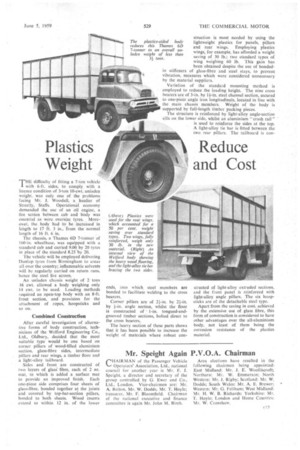Plastics Weight
Page 57

If you've noticed an error in this article please click here to report it so we can fix it.
THE difficulty of fitting a 7-ton vehicle with 6-ft. sides, to comply with a licence condition of 3-ton 10-cwt. unladen weight, was only one of the problems facing Mr. J. Woodall, a haulier of Streetly, Staffs. Operational economy demanded the use of an oil engine, a fire screen between cab andhi:J(1y was snsential as were oversize tyres. , More-• over the body had to be increased in length to 17 ft. 3 in., from the normal length of 16 ft. 6 in.
The chassis, a Thames 6D 7-tonner of 160-in, wheelbase, was equipped with a standard cab and carried 9.00 by 20 tyres in place of the standard 8.25 by 20.
The vehicle will be employed delivering Dunlop lyres from Birmingham to areas all over the country; inflammable solvents will be regularly carried on return runs, hence the steel fire screen.
An unladen chassis weight of 2 tons 16 cwt. allowed a body weighing only 14 cwt. to he used. Loading methods required an open-top body with an 8-ft. front section, and provision for the attachment of ropes, hoopsticks and so on.
Combined Consiruction
After careful investigation of alternative forms of body construction, technicians of the Welford Engineering Co., Ltd., Oldbury, decided that the most suitable type would be one based on corner pillars of wood-filled aluminium section, glass-fibre sides, intermediate pillars and rear wings, a timber floor and a light-alloy tailboard.
Sides and front are constructed of two layers of glass' fibre, each of 2 oz. mat, to which is added a surface mat to provide an improved finish. Each one-piece side comprises four sheets of glass-fibre, bonded together at the joints and covered by top-hat-section pillars, bonded to both sheets. Wood inserts extend to within 12 in. of the Tower
ends, into which, steel members are bonded to facilitate welding to the cross bearers.
Corner pillars are of 24-in. by 24-in.
by angle section, whilst the floor is constructed of ' 1-in, tongued-andgrooved timber sections, bolted direct to the cross bearers.
The heavy section of these parts shows that it has been possible to increase the weight of materials where robust con
struction is most needed by using the lightweight plastics for panels, pillars and rear wings. Employing plastics wings, for example, has afforded a weight 'saving of 30 lb.; two standard types of wing weighing 60 lb. This gain has been -obtained despite the use of bondedin stiffeners of glass-fibre and steel stays, to prevent vibration, measures which were considered unnecessary by the material suppliers.
Variation of the standard mounting method is employed to reduce the loading height. The nine cross bearers are of 3-in. by 14-in, steel channel section, secured to one-piece angle iron longitudinals, located in. line with the main chassis members. Weight of the body is supported by full-length timber packing pieces.
The structure is reinforced by light-alloy angle-section sills on the lower side, whilst an aluminium "crash rail" is used to reinforce the sides at the top. A light-alloy tie bar is fitted between the two rear pillars. The tailboard is con structed of light-alloy extruded sections, and the front panel is reinforced with light-alloy angle pillars. The six hoopsticks are of the detachable steel type.
Apart from the saving in cost, achieved by the extensive use of glass fibre, this form of construction is considered to have other advantages over the all-aluminium body, not least of them being the corrosion resistance of the plastics material.




































































































































